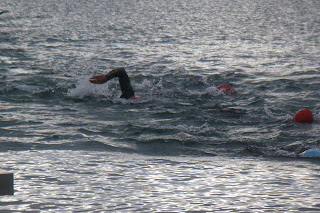 (5hr. ironman bike split... 112mi.)
(5hr. ironman bike split... 112mi.)I LOVE going fast!! But as fast as this bike looks, it's completely worthless without the proper engine to propel it. That engine must be powerful yet efficient. We will save the "power" discussion for another day, as it is worthy of it's own post. Today we will discuss how to maximize your current power and fitness levels while in a TT/Triathlon position. Keep in mind the majority of this is also applicable to road cycling as well.
Let's start with what I feel to be the absolute most pertinent question when dealing with pedaling efficiency, When do I exert force on the pedal?
Think of your crank like the hand on a clock, where the top is 12 and the bottom is 6 (as my left leg is in the photo above) Force should begin to be applied at roughly the 11 o'clock ( pushing the toes through the front of the shoe) and continued until around the 5 o'clock position (as if you were stepping up on a stair) At this time, the leg should relax as much as possible without causing additional resistance for the working leg. This gives a split second of recovery. (Over the course of 112mi. that split second can add up rather quickly) The reason for only applying force through 65-70% of your stroke is two fold. 1. The ability to recruit power from the hips and quads (drive and press phase) FAR exceeds your ability to recruit power from the hamstrings (pull phase) at a ratio of about 80/20. 2. Having fresh hamstrings is imperative to a fast run turn over. So resist the urge to pull up on your pedals if you are in a triathlon!!
Now that I know when to apply force, how often should I? This is what I tell my spin classes, "we need a good balance of resistance and cadence." Now there are triathletes that have found success grinding out a cadence of 60-65 for 112mi. but this is not something that I would recommend for everyone. I also don't advocate running at 11o the way many tour riders do. The fact is, cadence is something that is rather specific to the one pedaling. I find that a race cadence of around 90 in gear 7 or 8 in the flats is optimal for my power. Remember, a faster cadence allows for the removal of waste product form muscular contraction (lactate, carbon dioxide, ext.) due to increased heart rate. But increased heart rate also means lack of ability to absorb nutrients. (blood is pulled from digestive organs for use in peripherals)
In regard to body position, comfort is king! The most aggressive aerodynamic position is useless if you can not maintain it. At the 6 o'clock position there should be a slight bend at the knee and at the 12 o'clock the knee should be close to the elbow. The upper body is relaxed, the jaw, the finger tips, the shoulders, all relaxed. By relaxing every muscle not in active use, we allow more blood/oxygen/power/energy where it is needed. By practicing yoga we teach ourselves to relax in the most strenuous of positions. We also gain a very intuitive, almost visceral sense of body awareness. In other words, being able to feel exactly where that 11 0'clock position is every rotation. In addition to this, the tight curved body position that allows for better aerodynamics is made possible by our increased range of motion and flexibility.
This is a subject that I could go on and on about, but for the sake of brevity I will cease. If I left anything out or if you have questions please comment and I will respond. Remember that the point of a triathlon is not to have the fastest bike split, but to have the fastest race possible. This means being able to run off of the bike with speed and efficiency. (again, this is why we save our hamstrings)





